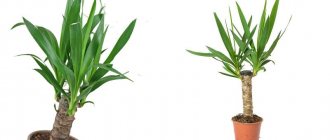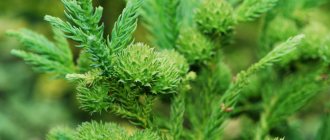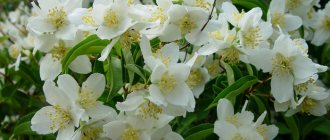Photo of rosemary Rosemary (Rosmarinus) - evergreen shrub. The plant belongs to the family Lamiaceae. It develops rapidly, growing by 0.2 m per year. Under natural conditions, over many years it can grow up to 1.5 m; domestic specimens are three times lower, but otherwise no worse than their wild counterparts.
Valued for its rich green branches dotted with small needle-like leaves reminiscent of pine needles. It blooms in late spring with small flowers, the colors of which can vary. In nature, it is distributed in the mountains of Crimea, the steppes of North Africa, and the forests of Southern Europe.
Densely planted plants are often used as hedges. The Mediterranean coast is considered the birthplace of rosemary.
Also see how to grow soleirolia and muraya plants.
| High growth rate, up to 20 cm per year. |
| Blooms in late spring with small flowers. |
| An easy plant to grow. |
| Perennial. |
Rosemary plant description
Rosemary is a perennial, evergreen plant belonging to the Lamiaceae family. This family also includes: sage, marjoram, thyme, oregano, basil, savory, lemon balm, mint and motherwort.
Close relatives of the spicy plant are such little-known representatives of the flora with “talking” names as: nutwing, bristletail, beautiful fruit, snakehead, catnip, ziziphora and odorous.
Rosemary is not an herb; it is a branched subshrub with blue flowers and small evergreen needle-like leaves.
The height of the plant can vary from 50 to 200 centimeters. The root system of the subshrub is very powerful and goes deep into the ground up to 4 meters.
The plant forms numerous branches. Old shoots harden over time, becoming olive-brown bark. And young ones remain green for a long period.
Rosemary leaves are narrow, leathery, grow densely and reach a length of 1.5-4 centimeters. They are slightly shiny above and slightly pubescent below. The leaves are linear in shape, thick, saturated with moisture, slightly curved at the edges and at the end. In general, they are very similar to spruce needles.
Rosemary has many positive properties. It is used not only as a spice for cooking and medicines, but also as an ornamental plant and landscape element.
The herbaceous minty aroma of rosemary will enchant anyone. Therefore, its oil is used in perfumery, pharmacology and phytocosmetology. Rosemary tastes slightly spicy and bitter. It is an indispensable ingredient in a mixture of Provencal herbs.
You can see what rosemary looks like in the photo below.
Other uses
Rosemary is considered a universal seasoning; it is part of such mixtures as Herbes de Provence and others, which culinary specialists, cooks, and confectioners add to meat, vegetable, fish dishes, baked goods, desserts, and in the production of cheeses. With a slightly bitter taste and camphor-like aroma, the spice is reminiscent of tarragon. It goes well with other herbs (parsley, juniper, thyme). If fresh herbs or dried spices are unavailable, they can be replaced with mint, lemon balm, and marjoram.
In addition to medicine and cooking, the plant has other uses:
- in landscape design it is used to design hedges, alpine slides, and when composing compositions;
- in veterinary medicine, powder from the leaves of the plant is used to rid animals of insects (fleas), for this they are simply sprinkled with the powder, or an infusion is prepared and the wool is rinsed with it after bathing;
- when performing magical rituals to expel evil spirits, as part of a love potion;
- In cosmetology, rosemary essential oil is used, which is included in formulations for the independent production of creams and masks or added to products for the skin of the face, hands, and body, purchased in a store or beauty salon.
Today, fresh or dried seasoning can be purchased in the store. When growing a plant yourself on your own plot, the collected greens can be dried or frozen for long-term storage.
Origin
The western part of the Mediterranean coast is considered the homeland of this unusual shrub. Rosemary is famous for its centuries-old history.
Historical facts
Translated from Latin, rosemary means “sea freshness”. The ancient Romans believed that the coastal sea wave gives the most delicate shade to flowers. This is where the name came from. People called this spice “incense herb”, “wedding flower” and “bride’s dress”.
- In ancient Greece, Egypt and Rome, rosemary was considered sacred.
- The ancient Greeks presented bouquets of rosemary as gifts to their goddess of love, Aphrodite. And in the Middle Ages, a bouquet of flowering plants was presented as a gift as a sign of prosperity and good luck. In some countries this tradition has been preserved to this day.
According to Christian legend: its white inflorescences acquired a delicate blue color when the Virgin Mary placed her cloak on the branches of the subshrub to hide little Jesus from the sun.
- The Egyptians placed blooming rosemary in the palms of the dead in order to brighten their path to the world of shadows with the aroma of freshness.
- The beauties of Hellas used this plant to care for their beautiful hair and delicate skin.
- The ancient Romans fumigated rooms with terminally ill people with rosemary and believed that the fresh smell warded off disease, death and evil.
- The Romans wove beautiful wreaths from plant branches and decorated themselves and their loved ones with them. It was the Romans who introduced Europe to this wonderful spice.
- The Hungarian Queen Erzsebet made a rejuvenating tonic from rosemary, which is why she was able to maintain her youth until she was 70 years old and seduce the Polish king.
- The flowers of the spice plant are a symbol of fidelity and eternal memory. They are often added to brides' wedding bouquets.
- In Turkey on the Gallipoli Peninsula, rosemary grew in large quantities and it was there that more than ten thousand Australian and New Zealand soldiers died during the First World War. Now in these countries on April 25, on the national holiday Anzac Day, those killed in military conflicts are remembered. On this day, veterans pin a branch of rosemary to their clothes.
- During World War II in France, hospitals burned rosemary leaves and juniper berries to protect against germs.
Where does rosemary grow?
Rosemary grows uncultivated in Europe, North Africa, Greece, Spain, Portugal and Cyprus.
The wild subshrub is not found in Russia. Here it is grown as a cultivated plant. Gardeners plant it in pots, and on summer days they take it out into the open air and leave it in a well-lit place. In Russia, it is grown in Crimea.
Rosemary is also cultivated on a factory scale on rosemary plantations:
- The plant is rich in esters and is famous for its unique properties. To produce essential oil, the tops of young stems are cut off along with flowers and leaves during the flowering period.
- To use rosemary as a seasoning, young branches are collected before flowering throughout the summer. The collected shoots are dried in the shade under a roof or awning and then ground. Or supplied fresh. In the form of a dry seasoning, it can be stored for 2-3 years.
Chemical composition and beneficial properties
Rosemary has long been used as a medicinal herb and spice. Its composition is rich in elements beneficial to the body. It contains:
- copper and iron;
- potassium and calcium;
- fiber and carnosol;
- rosmanol and alkaloids;
- manganese and magnesium;
- phytoncides and folic acid;
- vitamins A, C and B6;
- tannins and ursolic acid;
- rosmarinic acid;
- flavonoids.
This plant is high in saturated fat. Rosemary essential oil is highly valued due to the large number of beneficial substances in its composition. The largest amount of oils is found in the leaves of the plant. 1 tablespoon of ground leaves contains the daily requirement of vitamin A, which is very important for dental health, nutrition of body tissues, skin cells, and perception of colors by the organs of vision.
Rosemary has certain properties:
- antiseptic;
- bactericidal;
- balsamic;
- choleretic;
- sweatshops;
- antispasmodic;
- hypotensive;
- painkillers;
- diuretics;
- tonic;
- antirheumatic.
Benefits and treatment
- An infusion of rosemary herb improves well-being in case of asthma and respiratory diseases. Take as a rinse for the throat and nose. Can also be taken orally.
- Based on this plant, ointments and rubs for radiculitis are prepared. Also added to the bath to enhance blood circulation and relieve heaviness and swelling of the legs.
- It is used for menopause and menstrual irregularities in women. As prescribed by a doctor, it can be used during pregnancy to reduce toxicosis and irritability.
- Rosemary is used for diseases of the central nervous system; it helps stimulate mental activity and strengthens memory.
- Dried herb is used for digestive problems and flatulence.
- The use of this herb will be useful for people who have suffered a stroke. The plant increases blood pressure and increases heart rate. And in combination with lavender, it improves blood circulation in the brain.
- The beneficial substances that make up the plant are similar to sex hormones. Thanks to it, men can increase potency.
Uses of rosemary oil
Rosemary oil is very popular in the field of cosmetology and medicine. Products containing this product are recommended for use on depleted, faded hair, split ends, and for people prone to baldness. It is rubbed into the hair roots to speed up blood circulation and provide nourishment to the scalp. It also helps get rid of and prevent dandruff and seborrhea.
For problems with acne on the face, it is recommended to make compresses based on oil or simply wipe the face with it. This will help reduce inflammation and prevent acne.
Lotions are also used for problems with warts and the healing of old scars.
Due to its antiseptic properties, the oil is recommended for various damage to the skin, in order to heal and prevent the formation of visible scars.
When severe wrinkles appear, it helps reduce them and improve skin tone.
How rosemary blooms, features and life expectancy
The shrub blooms from April to July. In Israel, flowering can continue until November. The fruits ripen in September. The fruit resembles a nut: it is ovoid, smooth, and brown in color.
In summer, blue-violet inflorescences can be observed on the plant, which are slightly pubescent on the outside. The upper lip is notched, the lower is slightly longer than the upper.
Wild rosemary lives for 10-15 years, and at home it pleases the eye for 20-30 years.
It is unpretentious to the soil; it can grow even in rocky soil. But the bush does not tolerate excessive moisture in the ground. As a result, he dies or develops poorly. The structure of rosemary leaves helps it store moisture and thus withstand the summer heat.
And he certainly loves warm and arid climates, as he grows in open areas in the full sun. It does not tolerate cold weather, so its peak flowering occurs in the summer months.
Errors, diseases, pests and methods of eliminating them
| Complication | Elimination method |
| White coating on the leaves, which later turns brown. | The plant is affected by a pest - powdery mildew. It is necessary to remove the affected leaves of the plant and replant it in another soil, treat it with Baikal-M. |
| Dots began to appear on the leaves, the leaves curled into a tube. | This is a whitefly or aphid. The Admiral sprayer will help. |
| White translucent cobweb on the leaves. | The plant is affected by spider mites, you can get rid of it with a soap solution, if the disease is in the initial stage, with severe damage to the bush, you cannot do without insecticides. |
| White spots on leaves. | Occurs from excessive watering. It is necessary to temporarily stop watering and move the plant to a warm and bright place. |
| The leaves have wilted or turned yellow. | Lack of lighting; you need to move the rosemary to a well-lit room. Yellow leaves indicate insufficient watering; it is necessary to water the plant regularly, and it will perk up again. |
Types of rosemary
The subshrub has many varieties, but only 2 of them are the main types of rosemary and have a wide range of uses.
Common rosemary
It is the only species grown as a cultivated plant for culinary and pharmacological purposes. The species is distinguished by its unpretentiousness. It easily takes root both at home and in the garden.
Its foliage is lighter than other varieties. The inflorescences are closely adjacent to each other. Its flowers are of delicate shades: white, purple, pink and lilac.
Rosemary prostrate
Most often it can be found in southern latitudes. The bush has a spherical shape and reaches a height of 50-70 centimeters. Young leaves are thin, bright green. Old leaves are denser with a green-blue tint. In everyday life, it is mainly used for design and decorative purposes.
Varieties of rosemary
From rosemary (ordinary rosemary), breeders have been able to develop many different varieties. Rosemary varieties have slight differences in shape, leaf color, color palette, and area of application.
Corsican blue
Most often it is used for medical purposes. The leaves of this variety are grayish-green and have opposite leaf arrangement on the branch. The inflorescences grow in groups. They are small, blue, and have a bright aroma.
Blue winter
This variety is very popular among landscape designers. The shrub is adapted to frosty climates. The needle-shaped leaves are blue-green in color. Rosemary flowers are purple. It exudes a pleasant aroma of eucalyptus and pine needles.
Crimean
It has been growing on the Crimean peninsula since the 19th century. This variety is valued for its medicinal properties. It reaches a height of about one hundred centimeters. Does not tolerate temperature changes, is unpretentious to the soil and loves heat very much. Its leaves are dense blue-green. The flowers are white and purple.
Tenderness
This is one of the most popular varieties in Russia. He loves warm climates and bright sun. The height of the bush is about 90 centimeters. The leaves are usually green, but in September, when the fruit is formed, they darken and turn blue-green. They are thin, no more than 3 centimeters long. Flowers are blue.
Dewdrop
This variety of rosemary is widely used in cooking. Its leaves are dark green, very elongated, located tightly to each other, similar to spruce needles. They contain a large amount of essential oils that exude a mixed aroma of sea and lavender. The flowers are bluish-violet.
White
This variety is very rare. It is used for medicinal, culinary and decorative purposes. During flowering, the shoots reach 50-100 centimeters. Its leaves are bright green.
Ampelny
The variety is popular among landscape designers. It is thermophilic and rarely found in the wild, as the plant requires care. Its grown shoots twist and hang down bizarrely. It has bright green leaves and delicate purple flowers.
Features of growing at home. Briefly
If there is a lot of warmth and light in the room, rosemary feels right at home. Otherwise, the plant is unpretentious and requires basic care:
| Temperature | In winter, store at + 8 - 16 °C, in summer at + 25 °C. |
| Humidity | Medium, placed on a base of wet expanded clay. |
| Lighting | Bright, placed on a south or southwest window. |
| Irrigation | In summer - abundantly and often, in winter - up to three times a month; Do not allow the soil to dry out or stagnate. |
| The soil | Universal substrate for flowers; turf soil, peat, leaf litter and sand in equal parts. |
| Fertilization and nutrition | Twice a month after diluting twice with universal fertilizer. |
| Transplanting rosemary | Young bushes - every spring, adult bushes - once every 3.5 years. |
| Spreading | Cuttings or seeds. |
| Types of cultivation | The plant needs frequent aeration to avoid the main problem - mold. |
As with any plant, there are special cultivation measures.











